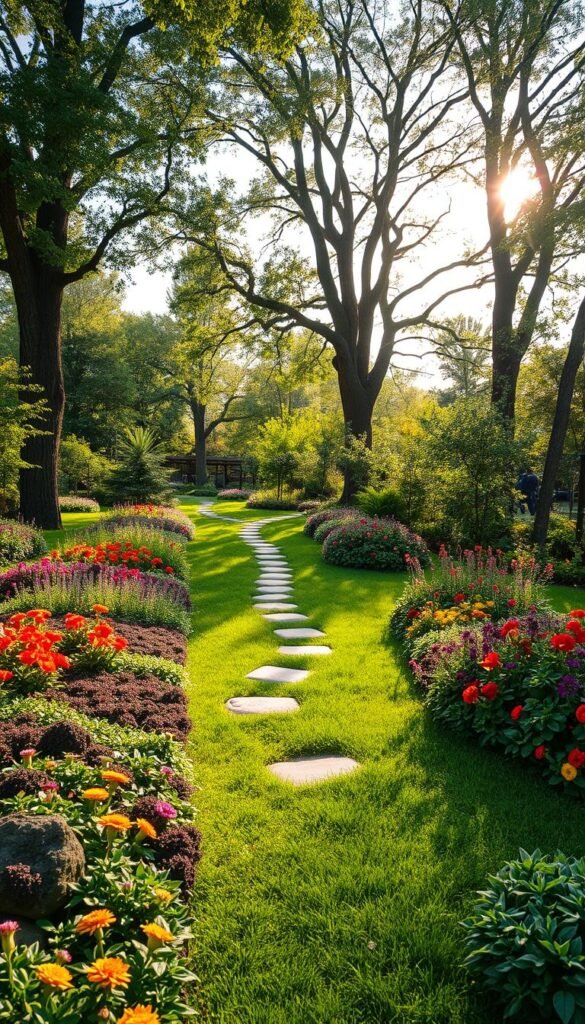Your front yard is more than just grass and soil—it’s the first impression of your home. Like a well-tailored outfit, it reflects your personality and sets the tone for what’s inside. Think of it as a blank canvas where every plant, pathway, and decorative accent tells your unique story.
Creating a space that feels authentically yours starts with blending practicality and beauty. Whether you’re working with a sprawling area or a cozy corner, design choices like sculptural trees or vibrant flower beds add layers of interest. Even small touches, such as a winding stone path or a reclaimed bench, can elevate your outdoor experience.
Transformation doesn’t mean starting from scratch. You can build your vision gradually—maybe begin with a focal point like a repurposed item that adds rustic charm. Over time, mix textures and colors through seasonal plants or artistic hardscaping. The goal? A space that evolves with your life while staying visually engaging year-round.
Remember, your outdoor area should work for you. Cozy seating nooks invite relaxation, while strategic lighting extends usability into the evening. Every choice, from bold patterns to subtle earth tones, contributes to the living masterpiece right outside your door.
Understanding Your Outdoor Space
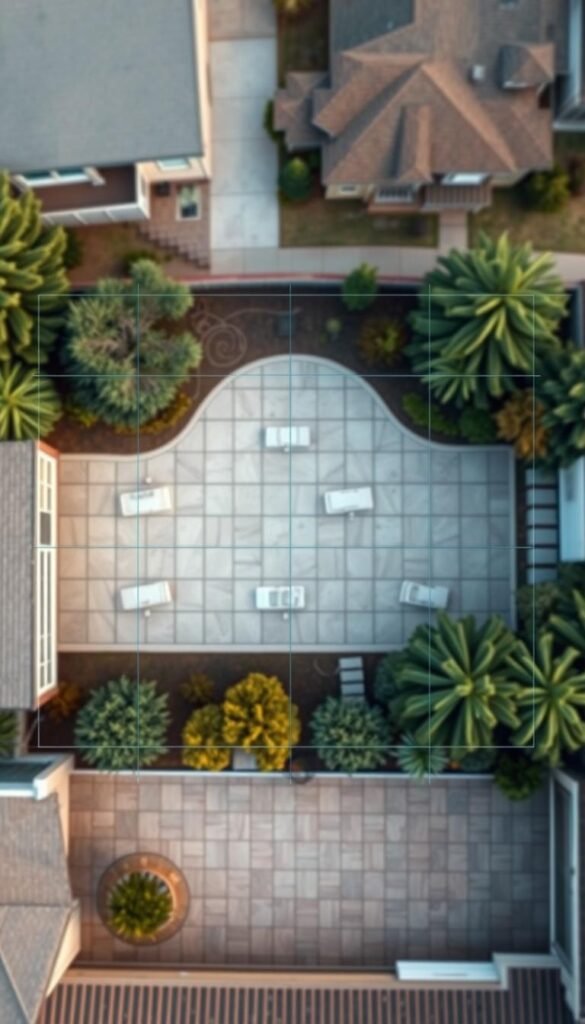
Start by getting to know your property’s unique characteristics. A thoughtful assessment helps you work with nature rather than against it, saving time and resources down the line.
Assessing Your Current Layout
Grab a tape measure and sketchpad. Document your entire space—front and back—to understand available room for projects. Note slopes, flat zones, and unusual shapes. These features influence everything from plant selection to seating placement.
Track sunlight patterns across seasons. Morning rays might highlight perfect spots for hydrangeas, while afternoon shade could host ferns. Watch how rainwater moves through your space—this reveals drainage issues before they become problems.
Spotting Trouble Zones
Every property has challenges. Look for:
- Bald patches where grass won’t grow
- Areas pooling water after storms
- Erosion-prone slopes
| Space Feature | Morning Light | Afternoon Shade |
|---|---|---|
| North Side | Limited | Consistent |
| South Slope | Full Sun | Partial |
| East Corner | Bright | Filtered |
Existing trees and shrubs offer structure. Decide which to keep—mature maples provide instant shade, while overgrown junipers might need removal. Mark underground utilities using professional guides to avoid costly mistakes.
Notice where family gathers naturally. These traffic patterns inform seating locations and pathways. For inspiration on blending function with beauty, explore gardening aesthetic strategies that transform ordinary spaces into intentional designs.
Setting Your Landscape Design Goals
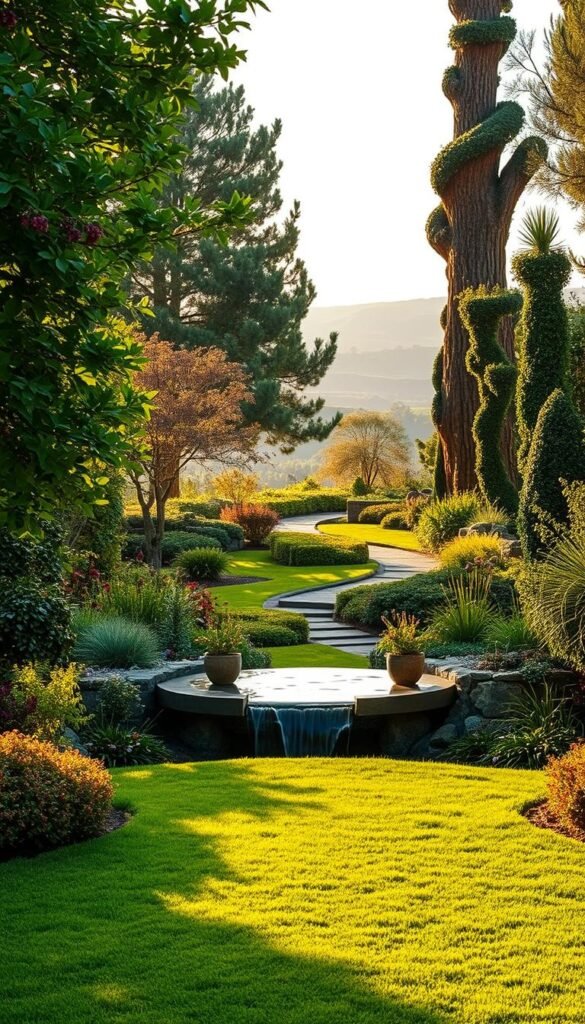
Crafting an outdoor space that truly works for you begins with clear intentions. Think of it as a partnership between what you need and what sparks joy. This balance turns ordinary areas into extensions of your daily life.
Evaluating Function and Aesthetics
Start by asking: How will this space serve your routine? Maybe you crave morning coffee nooks or weekend barbecue zones. Jot down top priorities:
- Kid-friendly play surfaces
- Low-maintenance dining patios
- Privacy screens for meditation corners
Next, match these needs with visual harmony. A sleek fire pit might complement modern architecture, while wildflower beds suit cottage charm. “Good design solves problems without shouting,” as one architect notes.
Prioritizing Family and Entertaining Needs
Map out activity zones like puzzle pieces. Dedicate 60% of your layout to daily uses—think dog runs or veggie plots—and reserve 40% for special moments. Consider:
- Expandable seating for summer gatherings
- Durable surfaces for game nights
- Flexible planters that adapt as kids grow
Your landscaping choices should enhance your home’s appeal while reflecting what matters most. Choose features that age gracefully, ensuring your design evolves alongside life’s changes.
Creative Garden Yard Ideas to Transform Your Lawn Into a Living Canvas
Imagine stepping outside to a space that feels like an extension of your imagination. Whether you crave relaxation or want to impress neighbors, these concepts turn ordinary grass into personal expressions.
Mediterranean vibes thrive in sunny climates. Picture lavender bushes framing decorative gravel paths, with a trickling fountain as your centerpiece. This style uses drought-resistant plants that save water while creating vacation energy.
For cottage charm, mix roses with wildflowers along winding stone walkways. Let clematis climb wooden arbors and add vintage lanterns for evening glow. It’s perfect if you love casual beauty that changes with the seasons.
Modern minimalism makes bold statements. Try rectangular concrete planters filled with ornamental grasses, paired with angular lighting fixtures. One designer notes: “Negative space can be as powerful as the elements themselves.”
- Zen retreats: Bamboo screens + pebble mosaics
- Edible landscapes: Raised herb beds + fruit trees
- Entertainment hubs: Built-in seating + weatherproof speakers
Japanese-inspired layouts bring calm through balance. Place boulders as focal points among maple trees, with a shallow koi pond nearby. Moss-covered stepping stones complete the serene atmosphere.
Your front yard’s potential depends on what makes you pause and smile. Start with one feature that sparks joy, then build outward. Every choice adds another brushstroke to your outdoor masterpiece.
Incorporating Low Maintenance Elements
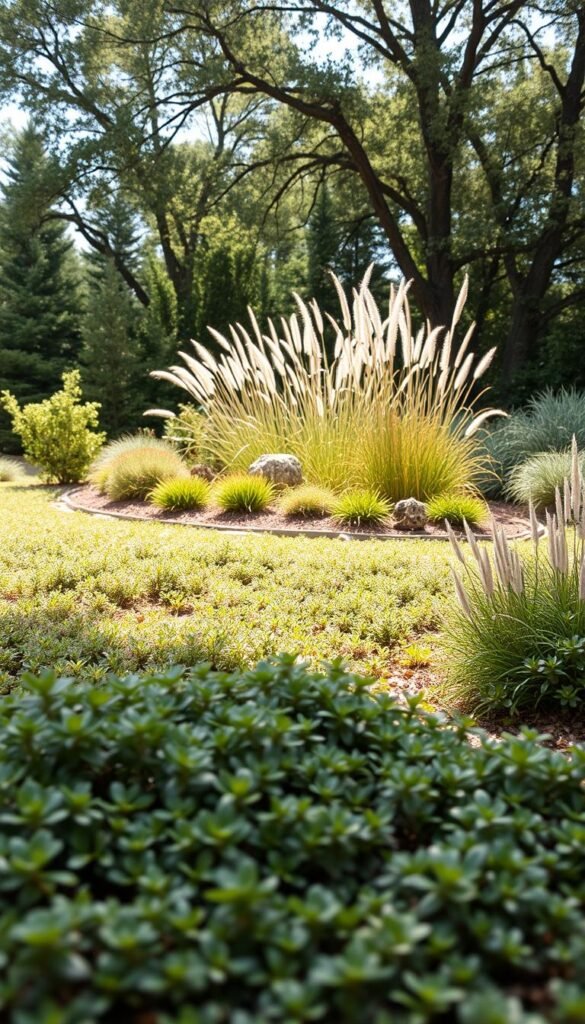
Creating an inviting outdoor space shouldn’t feel like a part-time job. Smart choices in materials and greenery let you enjoy your surroundings without constant upkeep. Start by reimagining traditional lawn care with solutions that blend practicality and style.
Exploring Artificial Turf and Alternative Lawn Options
Artificial turf offers the look of natural grass without weekly mowing or watering. Modern versions mimic real blades’ texture and color variations, staying vibrant through droughts and heavy foot traffic. For a softer approach, consider clover lawns—they stay green with minimal water and attract pollinators.
Ground covers like creeping thyme thrive in sunny spots, releasing fragrance when stepped on. Gravel or mulch beds work well for defining areas while suppressing weeds. As one landscaper notes: “The best designs solve problems before they start.”
Selecting Drought-Tolerant and Native Plants
Native species naturally thrive in your region’s climate, needing less water and pest control. Mediterranean herbs like lavender add fragrance, while succulents bring sculptural shapes. Evergreen shrubs provide year-round structure without leaf cleanup.
Pair these with ornamental grasses for movement and texture. For low-maintenance landscaping ideas, focus on plants that match your soil type and sunlight. Mix in budget-friendly gardening solutions like dividing perennials or swapping cuttings with neighbors.
Your space becomes easier to manage when every element works smarter—not harder. Choose wisely, and your weekends stay free for enjoying lemonade instead of pulling weeds.
Designing with Hardscape and Softscape Features

The secret to a balanced outdoor design lies in marrying permanent structures with living elements. Observe where grass struggles underfoot—those worn trails reveal natural traffic patterns begging for intentional solutions.
Integrating Walkways, Mulch, and Gravel Paths
Transform muddy shortcuts into charming routes. Gravel offers instant drainage and crunch underfoot, while mulch beds soften edges near planting zones. Both materials prevent soil compaction, letting roots breathe.
Pavers create defined walkways that guide movement. Choose irregular flagstones for rustic appeal or geometric patterns for modern flair. For cottagecore charm, border paths with creeping thyme that releases fragrance when brushed.
Balancing Stones, Pavers, and Concrete Elements
Scale matters. Use large concrete slabs for patios, then break their uniformity with stone accents. Pebble mosaics add whimsy between pavers, while boulders anchor sloped areas.
Mix textures thoughtfully: smooth concrete contrasts with rough-cut stones. “Hardscapes should frame plants, not compete with them,” notes a landscape architect. Keep mulch layers fresh to unify beds with adjacent paths.
Exploring Seating Areas and Outdoor Living Spaces
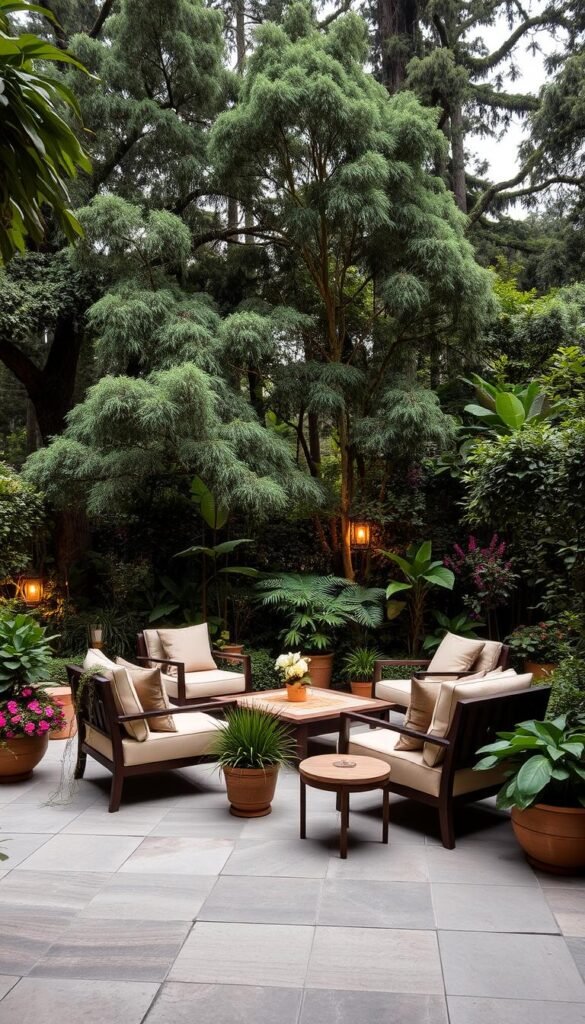
Turn your outdoor zones into purposeful retreats that serve daily needs and special moments. Thoughtful placement of chairs, tables, and gathering spots turns empty stretches into space that feels as intentional as your living room.
Creating Cozy Nooks and Relaxing Patios
Position your main seating area close to indoor kitchens for effortless hosting. This makes carrying trays or refilling drinks a breeze during barbecues. For quiet corners, tuck a bench beneath blossoming cherry trees or arrange Adirondack chairs where morning light filters through leaves.
Divide your layout into activity zones. A deck with a dining table suits family dinners, while a sunken patio with sectional seating invites evening conversations. One designer suggests: “Use elevation changes to define areas without physical walls.”
Consider these multi-functional ideas:
- Built-in bench storage for cushions and games
- Fire pits doubling as coffee tables
- Retractable awnings over bistro sets
Elevated deck spaces solve slope challenges while creating visual interest. For narrow areas, try vertical planters beside lounge chairs to maintain walkways. Remember—your patio should invite you to linger, whether you’re savoring solitude or hosting friends.
Adding Water Features for a Refreshing Touch
Water brings life to any outdoor space, offering both visual calm and soothing sounds. In warmer climates where freezing isn’t a concern, bold features like cascading fountains or shallow ponds require minimal upkeep. Highlight your water element after dark with strategic spotlights—angle them to dance across the surface while illuminating nearby annuals like petunias or marigolds.
Think you lack room? Get creative. Wall-mounted spouts or compact tabletop basins add liquid charm to patios. Even a whiskey barrel turned mini pond attracts dragonflies while fitting snugly beside seating areas.
Pair your water element with a nearby fire pit to balance nature’s elements. The contrast of flickering flames and rippling water creates dynamic energy for evening gatherings. Surround both features with smooth stones or ornamental grasses to unify the design.
These elements work harder when layered. Floating plants like water lilies reduce algae growth, while submerged pumps keep water circulating. Your new oasis becomes a habitat for birds and a peaceful retreat for you—no backyard overhaul required.

